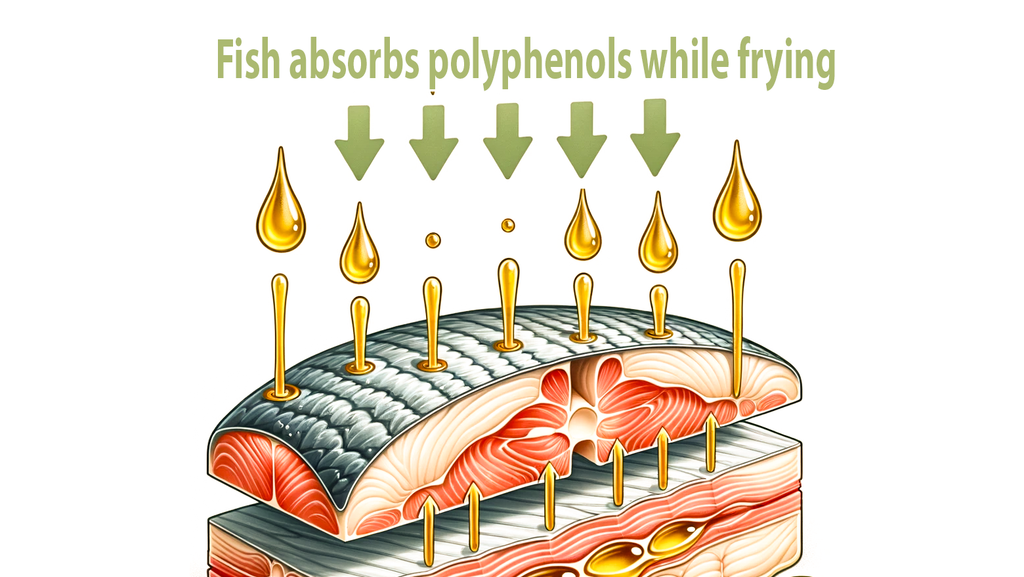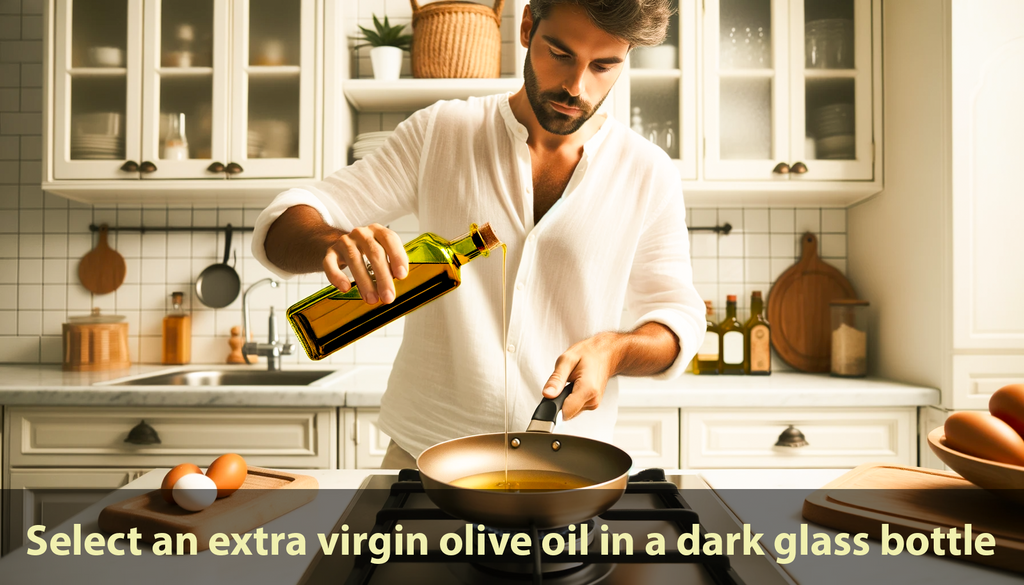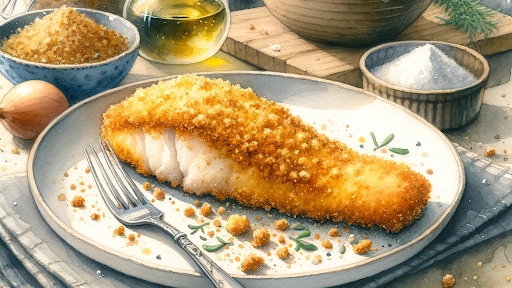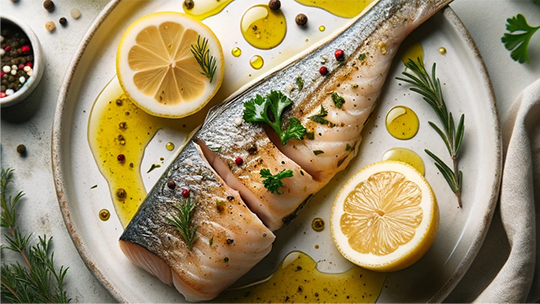Ever found yourself pondering over whether olive oil is your best bet for frying fish? Trust me, you're not alone. Many have asked, "Can you fry fish in olive oil?".
Olive oil has often been sidelined for frying due to misconceptions about its smoke point and suitability. But what if I told you that not only can you fry fish in olive oil, but it might also be one of the best choices for all your seafood delicacies? I too was once caught in this culinary conundrum until I decided to dive headfirst into some serious research.
And here's the exciting revelation: Not only can you absolutely fry fish in olive oil, but it also packs an array of health benefits, especially when you decide to sizzle your fish with fresh olive juice!
This blog busts the common myths against frying fish with olive oil and promises to be your ultimate guide on how to masterfully fry fish using this nutrient-packed ingredient.
Get ready to take your health to the next level with the perfect power couple: fish and olive oil!
These 2 nutritional superstars are inseparable when it comes to frying and cooking, and when it comes to promoting a healthy lifestyle. Stunningly delicious fried fish recipes and tips are also just around the corner!
Table of Contents
- Key Takeaways from the Study
- The Truth About Frying Fish in Olive Oil and Why it Matters
- Clearing Up the Smoke About Olive Oil’s “Low Smoke Point”
- It’s All About the Heat Stability, Not Smoke Point
- Packing a Polyphenol Punch: How Your Fried Fish Absorbs Olive Oil Antioxidants
- Tips for choosing the right kind of olive oil for frying
- The 13 Golden Rules for Perfect Pan-fried Fish
- Choosing the right fish for frying
- Essential equipment and pan selection
- Recipe Variations for Delicious Pan-Fried Fish
- Using breadcrumb for a crispy coating
- Using Mediterranean Herbs & Garlic Fried Fish
- Incorporating other herbs and spices for added flavor
- Serving Suggestions and More Fish Recipes
- What to serve with pan-fried fish
- Other fish cooking methods and recipes
- Conclusion
- FAQs
- References
Key Takeaways from the Studies
- Polyphenols Absorption During Frying: Research from 2007 revolutionized our understanding of cooking with extra virgin olive oil (EVOO). It revealed that when fish is fried in EVOO, it absorbs polyphenols during the frying process. This interaction enhances the nutritional profile of the fish, infusing it with these beneficial compounds.1
- Unrivaled Heat Stability Due to Polyphenols: Subsequent studies shed light on why EVOO's heat stability is superior to other cooking coils. The antioxidant power present in the polyphenols of EVOO confer it the highest heat stability of any cooking oil. This stability is vital for maintaining the both the integrity and nutritional quality of both the oil and the food during cooking and frying.2
- Antioxidants Preventing Toxic Compounds: The high antioxidant power inherent in high polyphenol EVOO plays a crucial role beyond just Heat Stability. These antioxidants are also instrumental in preventing the formation of harmful by-products during cooking and frying. This protection against genotoxic and carcinogenic substances like aldehydes makes EVOO a safer choice for cooking.3
- 2023 Discovery Of Hydroxytyrosol's Role: Building on this extensive research, 2023 studies pinpointed Hydroxytyrosol as the specific olive oil polyphenol responsible for preventing the oxidation and degradation of Omega-3 fatty acids when frying fish. This breakthrough provides a deeper understanding of how EVOO protects seafood's essential nutrients like Omega 3 even under the stress of high heat.4
- Health Benefits of Omega-3 and EVOO: Omega-3 fatty acids, abundant in seafood, are renowned for their health benefits, including the prevention of cardiovascular diseases, dementia, and Alzehimer's disease. Therefore preserving these vital nutrients is of utmost importance, and that's why choosing a high-quality EVOO for frying fish is critical to ensure you reap the full health benefits of the Omega 3's in your fish.5

The Truth About Frying Fish in Extra Virgin Olive Oil and Why it Matters
You may have heard that olive oil is not the best oil for frying fish, but let me set the record straight. When comparing to the long list of other cooking oils (e.g. vegetable oil, canola oil, safflower oil, peanut oil, etc.) using a fresh extra virgin olive oil comes out on top when it comes to your health!
Fish is naturally rich in Omega-3 fatty acids, such as DHA and EPA, which have been shown to reduce the risk of Dementia and Alzheimer's disease.4
These fats play a vital role in controlling various cellular activities like arrhythmias, atherothrombosis, and inflammations.5
However, if you use low-quality cooking oil to fry your fish, the healthy Omega-3's may become compromised and potentially harmful when consumed in an oxidized form. That's why it's crucial to preserve the Omega-3s during cooking and frying. And that's where olive oil comes in to save the day!
Olive oil contains a powerful polyphenol called Hydroxytyrosol. There have been hundreds of studies over the years illustrating this unique compound’s properties as an antioxidant, anti-inflammatory, and anticancer agent. Now, based on cutting edge research from 2023, Hydroxytyrosol has now been proven to inhibit oxidation during high heat cooking, even at extreme temperatures during deep frying!4
The findings of this study have important implications for the food industry, as they suggest that the addition of extra virgin olive oil antioxidants like Hydroxytyrosol should be added to all cooking oils and food products to help preserve the quality and nutritional value.
When it comes to your family’s health, compromising on anything less than extra virgin olive oil high in antioxidants should never be an option! Don’t compromise the Omega 3's in your fish by using the wrong oil. Ensure you're obtaining their full benefits!
Clearing Up the Smoke About Olive Oil’s “Lower Smoke Point"
A fresh extra virgin olive oil enriches the omega-3 content of the dish, contributing to heart and brain health, but there are actually 2 other benefits as well!
1) Due to its resilience against degradation from thermal oxidation, olive oil remains stable even when heated up for frying; a clear advantage over other oils such as sunflower oil that isn’t even close to comparing!2
2) Most importantly, extra virgin olive oil produces fewer potentially harmful compounds during frying compared with other options. In fact, the USDA recommends olive oil for deep frying, the highest temperature form of frying!6 Even the "healthier oils" like avocado oil and coconut oil do not match olive oil's high heat stability!
Therefore, whenever you're thinking of the perfect way to fry that special filet, remember these unique advantages offered by olive oil.
It’s All About the Heat Stability, Not Smoke Point
Many people believe that olive oil has a low smoke point, making it unsuitable for frying. This popular myth isn't entirely true. The smoke point thought to be the temperature at which it starts to break down and produce visible emissions of smoke. But, is that really always true?
While refined oils with "high smoke points" are often chosen for frying (e.g. vegetable oil, canola oil, coconut oil, safflower oil, peanut oil, sunflower oil), extra virgin olive oil is your healthiest option because it can better withstand medium-high cooking temperatures up to 410°F (210°C). According to “North American Olive Oil Association”, Extra Virgin Olive Oil has the highest heat stability meaning it can best withstand high temperatures.
To clear the confusion up, there are 3 points that matter:
- The reason everyone is so focused on the smoke point temperature is because that’s what’s thought to be the point at which the oil breaks down and forms toxic compounds. But in reality, the smoke point doesn’t have to be reached for cooking oil to start breaking down at high temperatures. What matters is Heat Stability!
- Practical cooking temperatures (such as stove-top frying), can exceed 400°F, but it's never recommended to fry at higher temperatures than this. In fact, deep frying, which is considered to be the hottest form of frying, should not exceed 400°F if you don’t want to burn your food! Therefore, there is no need to be concerned that your olive oil’s "lower smoke point" will ever even be crossed, especially if you are monitoring your cooking oil's temperature with an Infrared Thermometer.
- When people claim that “olive oil smokes faster” when they cook it, they do not realize that the smoke they are "seeing" is simply the water content of the olive oil evaporating and not the actual olive fat smoking!
In this new 2023 groundbreaking study, researchers have finally uncovered the the special polyphenol responsible for the incredible health benefits of frying fish in olive oil. This study reveals these the healthy polyphenols that naturally get absorbed in fish during frying contain a very special polyphenol called Hydroxytyrosol, which is especially powerful for protection against oxidation and degradation. The start of the show is Hydroxytyrosol, a unique compound found exclusively in olive oil!
Previous studies already illustrated how the polyphenols of extra virgin olive oil migrate and are absorbed fish during frying.
This 2023 study illustrates how Hydroxytyrysol prevents toxic compounds during cooking and frying!
This 2023 study sheds more light on the previous studies that illustrated how antioxidants have a positive impact on the lipid profile in the fish and minimize the generation of toxic compounds during frying. This is crucial for food safety and our overall health.

Packing a Polyphenol Punch: How Your Fried Fish Absorbs Olive Oil Antioxidants
Not only do the antioxidants in olive oil preserve the healthy Omega 3's of the fish itself, they end up infusing into the fish itself during the frying process!4 It’s been shown in multiple studies that during frying in olive oil, antioxidants from the olive oil are transferred to the fish, and it's also been shown to also occur when frying Vegetables.3
The antioxidant content of the fish ends up being higher after frying!
In fact, using olive oil for frying not only enhances the taste but also infuses essential nutrients into your dish. Olive oil contains monounsaturated fats and antioxidants, known for their heart health benefits.
Next time you're planning to cook something delicious and nutritious like pan-fried fish, make sure to choose a high-quality extra-virgin olive oil. Your taste buds and your body will thank you for it!
Can you fry fish in olive oil and still maintain the Omega 3 health benefits?
Certainly, and the results are deliciously evident!
It's not just making the healthiest choice, but also about achieving rich flavor and texture.

Tips for Choosing the Right Kind of Olive Oil for Frying
Getting the right olive oil for frying your fish can be made simple, just follow these tips:
- Opt for First Cold Pressed Extra Virgin Olive Oil: It's rich in nutrients and possesses a high smoke point and heat stability perfect for frying.
- Check the acidity level: A lower acidity means superior quality, ideal for frying. Look for FFA < 0.3
- Know your brands: Go for reputable brands which prove their commitment to purity and quality.
- Watch out for the harvest date: Olive oil doesn't age like wine. Fresher oils offer better taste and higher nutritional value.
- Choose oils stored in dark, glass bottles: Glass is non porous eliminating chemical reactions between EVOO and the container overall prolonging its shelf life. Light can degrade olive oil, reducing its beneficial properties.
- Check the origin: it should come from one country, even better from one single county or farm
- Check for the presence of Vitamin E and K in the Nutritional Panel: their presence is a strong indication that the oils were truly obtained using First Cold Pressing technology able to retain vitamins. The higher the level of vitamins, the higher the levels of polyphenols, the higher the quality of the EVOO
The 13 Golden Rules for Perfect Pan-fried Fish
Pan-frying fish in olive oil is a great way to achieve a delicious and healthy meal. Here are my 7 golden rules for perfect pan-fried fish:- Choose the right fish: Opt for firm-textured fish filets like salmon, cod, or halibut, as they hold up well during cooking.
- Season the fish: Season both sides of the fish filets with salt and pepper or any other desired herbs and spices.
- Use a thick, heavy bottom pan (e.g. cast iron pan): This prevents uneven heat distribution, which can result in burnt and undercooked spots.
- Preheat your pan: Make sure your pan is hot before adding the fish. This helps to prevent sticking and ensures a crispy exterior.
- For ½’ filet’s 345 ℉ is ideal.
- For a 1” thick filet, frying at 375 ℉ is ideal.
- Use the right amount of oil: Coat the bottom of your pan with a thin layer of olive oil. You want enough to prevent sticking but not so much that the fish becomes submerged because of too much oil (this would be a deep fry!).
- Carefully drop fish: Drop the filets away from yourself, so oil doesn’t splatter back on you at the end!
- Cook on medium heat, but don’t be afraid to adjust: Heat your pan over medium heat to ensure even cooking without burning the outside of the fish. Remember, medium heat for typical stove tops should not surpass 400℉. An easy way to monitor is by using an Infrared Thermometer.
- Make sure the fish stays in the oil: if there’s dry spots on your pan, move the fish towards the oil to ensure an even cooking on the surface. The result will be a perfect golden brown!
- Monitor cooking time: Cook each side of the fish for about 3-4 minutes per side, depending on thickness. The flesh should be opaque and easily flake with a fork.
- Leave it alone: Try not to mess around with it too much as it’s frying to avoid uneven cooking.
- Don't overcrowd the pan: Cook the fish in batches if necessary, allowing enough space between each filet for proper browning and texture. Overcrowding can result in steaming, which prevents the perfect golden brown you are shooting for!
- Carryover Cooking: After an Internal Temperature of 135℉, let it rest and increase to 140℉ to avoid overcooking and dryness. This is why a meat thermometer for the fish and infrared thermometer for the oil can prove to be particularly useful so that you can get it down to a science!
Choosing the right fish for frying
When it comes to choosing the best fish for frying, there are a few key factors to consider. First and foremost, you want to select a firm fleshed fish that can withstand the high heat of frying.
Good options include cod, haddock, hake, pollock, flounder, smelts, tilapia, and catfish. These varieties have a mild flavor that pairs nicely with the crispy texture of fried fish.
Additionally, you'll want to take into account any dietary restrictions or preferences when selecting your fish. If you're looking for a healthier option, consider choosing fatty fish such as salmon or mackerel which are rich in omega-3 fatty acids and have numerous health benefits.
Discovering the perfect fish for frying is an art that fish cooks learn with experience.
Essential equipment and pan selection
When frying fish in olive oil, it is important to have the right equipment and pan to ensure optimal results. Here are some essential items you will need:
- A deep skillet or frying pan: Choose a pan with high sides to prevent oil splatter and allow for easy flipping of the fish.
- A non-stick surface: Opt for a non-stick pan to prevent the fish from sticking and breaking apart during cooking.
- A thermometer: Use a cooking thermometer to monitor the oil temperature accurately. This will help you achieve crispy and golden fish without overcooking or burning it.
- Wooden utensil: A wooden utensil is best because due to choosing a pan with a non-stick surface, wood is simply better so you do not scratch the surface.
- Paper towels or a wire rack: Place fried fish on paper towels or a wire rack after cooking to absorb excess oil and keep it crispy.
Recipe Variations for Delicious Pan-Fried Fish
Discover how to take your pan-fried fish to the next level with these tantalizing recipe variations. From adding a twist with EVOO, to using breadcrumbs and parmesan for a crispy coating, you won't want to miss these mouthwatering ideas.

Using breadcrumb for a crispy coating
I love using breadcrumbs to create a crispy coating for my pan-fried fish. It adds an extra layer of texture and flavor that takes the dish to a whole new level. Here are some tips for achieving that perfect crispiness:
- Start by mixing together breadcrumbs in a shallow bowl or plate. The ratio can vary depending on your preference, but I usually go with equal parts of each.
- Before coating the fish, make sure it is dry by patting it with paper towels. This will help the breadcrumb mixture adhere better.
- Dip the fish fillets into beaten eggs or milk to moisten them. Then, press them firmly into the breadcrumb mixture, making sure every part is coated evenly.
- Heat some extra virgin olive oil in a frying pan over medium heat until hot. You can also use butter as well if you prefer, but keep in mind that it may not give you as crispy of a coating.
- Carefully place the coated fish filets into the hot oil and cook them for a few minutes on each side until they turn golden brown and crispy.
- Once cooked, transfer the fish onto a paper towel - lined plate to absorb any excess oil.
- Serve your deliciously crispy pan - fried fish immediately while it's still hot and crunchy.
Using Mediterranean Herbs & Garlic Fried Fish:
Fish:
- Use fresh fish filets.
- Rinse and pat dry.
- Season both sides with salt, pepper, and lemon zest.
- Dredge each filet in flour, shaking off excess.
Olive Oil:
- In a skillet, heat a good amount over medium-high.
Aromatics:
- Add 3-4 minced garlic cloves, 2 tsp finely chopped fresh rosemary, and 2 tsp finely chopped fresh thyme to the skillet.
- Sauté until fragrant (~1 minute).
Fry the Fish:
- Add the seasoned and dredged filets to the skillet.
- Fry until golden brown on one side, then flip.
- Continue frying until the other side is golden brown and the fish is cooked through.
Lemon:
- Just before removing the fish, squeeze the juice of 1 lemon over the filets.
Garnish:
- Transfer the fish to a plate.
- Garnish with freshly chopped parsley.
Incorporating other herbs and spices for added flavor
I love experimenting with different flavors when I cook, and adding herbs and spices to pan-fried fish is a great way to elevate the taste. Here are some delicious combinations to try:
- Lemon and Dill: Sprinkle fresh dill and squeeze some lemon juice over the fish right before serving. The citrusy flavor of lemon combined with the aromatic herb will give your fish a bright and refreshing taste.
- Garlic and Paprika: Create a flavorful crust by mixing minced garlic with smoked paprika, salt, and pepper. Rub this mixture onto the fish before frying for a deliciously seasoned coating.
- Mediterranean Herbs: Create a Mediterranean-inspired dish by sprinkling dried oregano, basil, or thyme on your pan-fried fish. These herbs pair perfectly with olive oil and bring out the delicate flavor of the fish.
Serving Suggestions and More Fish Recipes
When it comes to serving pan-fried fish, there are plenty of delicious and healthy options to consider. Serve your perfectly cooked fish with a side of lemon aioli for a tangy twist, or pair it with a fresh green salad tossed in a light vinaigrette.
If you're feeling adventurous, try topping your fish with a flavorful salsa verde or even some homemade tartar sauce. And don't forget about the versatility of fish tacos - load up your crispy fried fish into warm tortillas and garnish with avocado, cilantro, and a squeeze of lime.
The possibilities are endless when it comes to serving suggestions for your deliciously pan-fried fish!
What to serve with pan-fried fish
When it comes to serving pan-fried fish, there are plenty of delicious and healthy options that complement its flavors perfectly. Here are some ideas to inspire your next meal:
- Fresh vegetable medley: Pair your pan-fried fish with a colorful mix of steamed or roasted vegetables. Broccoli, carrots, bell peppers, and zucchini make a vibrant and nutritious side dish.
- Lemon herb rice: Cook fluffy white rice and toss it with fresh herbs like parsley and dill, along with a squeeze of lemon juice. The tangy flavors will complement the crispy fish.
- Crispy roasted potatoes: Serve your pan-fried fish alongside some crispy roasted potatoes for a comforting and filling meal. Season them with herbs, garlic powder, or paprika for extra flavor.
- Quinoa salad: Prepare a light and refreshing quinoa salad by mixing cooked quinoa with diced cucumbers, cherry tomatoes, red onions, and a zesty vinaigrette dressing.
- Grilled asparagus: Fire up the grill and cook some tender asparagus spears seasoned with salt, pepper, and a drizzle of olive oil. The smoky flavor pairs beautifully with the fish.
Other fish cooking methods and recipes
I love experimenting with different cooking methods for fish, and there are so many delicious options to try. Here are some other fish cooking methods and recipes that you can explore:
- Grilling: Grilling fish is a fantastic way to infuse it with smoky flavors. Brush the fish with olive oil and season it with your favorite herbs and spices. Place it on a preheated grill, sear each side until cooked through, and enjoy the charred goodness.
- Baking: Baking fish is easy and hassle-free. Preheat your oven to the recommended temperature, place the seasoned fish filets on a baking sheet lined with parchment paper, and bake until flaky and tender. You can enhance the flavor by adding lemon slices or a drizzle of olive oil.
- Steaming: Steaming is a healthy and gentle way to cook fish while retaining its natural flavor and nutrients. Season the fish filets with salt, pepper, and any desired herbs or spices. Place them in a steamer basket over boiling water, cover with a lid, and steam for about 10 minutes or until done.
- Poaching: Poaching fish in liquid imparts moisture into the flesh while adding subtle flavors. Prepare a poaching liquid by combining broth, wine, or water with aromatics like onion, garlic, and herbs. Bring the liquid to a simmer, add the seasoned fish filets, poach gently until cooked through, then serve alongside the flavorful liquid.
- Broiling: Broiling quickly cooks fish under high heat, resulting in crispy skin or crusty toppings. Place seasoned fish filets on a broiler pan or baking sheet lined with foil. Position the rack so that the top of the fish is 4-6 inches from the broiler element. Cook for a few minutes on each side until nicely browned.
Conclusion
According to this groundbreaking 2023 study, frying fish in olive oil is key to preserving the essential Omega 3's in your fish. And the secret ingredient? Hydroxytyrosol, a unique polyphenol found only in olive oil.
But the benefits don't stop there! Countless studies have shown that frying in high-quality olive oil is one of the healthiest ways to cook your food. The antioxidants and polyphenols in olive oil have been shown to reduce harmful by-products of frying oil degradation, such as aldehydes and other toxic substances.
Imagine enjoying a plate of crispy, flavorful fried fish that's bursting with Omega 3's and antioxidants. And the best part? You won't have to worry about these vital nutrients being depleted by the frying process. They're protected by the power of polyphenols!
So can you fry fish in olive oil and still reap the Omega 3 health benefits? The answer is a resounding yes!
Make sure to use quality olive oil when preparing your next seafood feast, and reap all of the fantastic benefits your fried fish has to offer!
By following the 13 Golden Rules for Perfect Pan-fried Fish and choosing a fresh extra virgin olive oil high in polyphenols, your taste buds and health will thank you!
FAQs
Can you use olive oil to fry fish?
Absolutely! You can use olive oil for both pan-frying and deep frying fish. Fresh extra-virgin olive oil has been proven to be the best oil for frying because of its high stability and high antioxidant content, and this is why the USDA recommends it for deep frying, the hottest and crispiest form of frying!
What will the texture and color of the fried fish be when using olive oil
Fish fried in olive oil typically has a golden-brown color with a crispy texture, and with batter, it turns delightfully crisp during the frying time.
Is it safe to fry fish in olive oil?
Yes! Frying safety includes monitoring your oil temperature and handling hot pans carefully; doing so at the right temperature and the right quantities (fish and oil) makes using olive oil for frying not only safe but also affordable!
How does the taste of battered deep-fried fish compare when cooked with different oils?
While there may be subtle differences based on individual preferences, generally, the batter absorbs less grease when you deep fry in Olive Oil, assuring you a crispy delicious meal every time!
What type of packaging should olive oil be stored in?
The best way for olive oil to be stored is in glass, preferably dark, opaque glass.
Disclaimer: The content in this blog is for informational purposes only and should not be taken as professional medical advice.
References:
(1) Recovery and distribution of natural antioxidants (a-tocopherol, polyphenols and terpenic acids) after pan-frying of Mediterranean finfish in virgin olive oil. Food Chemistry, 2007.
Date Accessed: 10/10/2023
(2) Olive Oil Stability under Deep-Frying Conditions. Food and Chemical Toxicology: An International Journal Published for the British Industrial Biological Research Association, 2010.
Date Accessed: 10/10/2023
(3) Phenols and the antioxidant capacity of Mediterranean vegetables prepared with extra virgin olive oil using different domestic cooking techniques. Food Chem. 2015 Apr 28.
Date Accessed: 10/10/2023
(4) "The Inhibitory Effects of Hydroxytyrosol, a-Tocopherol and Ascorbyl Palmitate on Lipid Peroxidation in Deep-Fat Fried Seafood." Antioxidants & Redox Signaling 2023.
Date Accessed: 10/25/2023
(5) Selective concentration of EPA and DHA using Thermomyces lanuginosus lipase is due to fatty acid selectivity and not regioselectivity. Food Chem. 2013.
Date Accessed: 10/25/2023
(6) North American Olive Oil Association, 2023.



